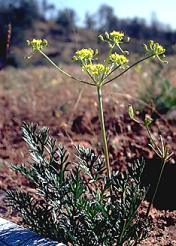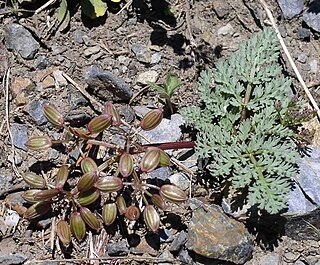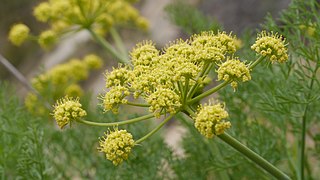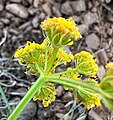
Lomatium bicolor is an herb of the family Apiaceae that occurs in two varieties, Lomatium bicolor var. leptocarpum and Lomatium bicolor var. bicolor.

Lomatium canbyi is a species of flowering plant in the carrot family known by the common name Canby's biscuitroot. It is native to the Pacific Northwest of the United States and northeast California, where it grows in sagebrush-covered plateau habitat and barren flats.

Lomatium columbianum is a perennial herb of the family Apiaceae known by the common names purple leptotaenia and Columbia desert parsley. It is endemic to the U.S. states of Oregon and Washington, mostly along the Columbia River east of the Cascades.

Lomatium congdonii, known by the common names Mariposa desertparsley and Congdon's lomatium, is a species of flowering plant in the carrot family.

Lomatium cuspidatum is a perennial herb of the family Apiaceae, native to the U.S. state of Washington. It is found primarily on open rocky slopes in the Wenatchee Mountains, strongly associated with serpentine scree and soils.

Lomatium grayi, commonly known as Gray's biscuitroot, Gray's desert parsley, or pungent desert parsley, is a perennial herb of the family Apiaceae. It is native to Western Canada in British Columbia, and the Western United States, including from the Eastern Cascades and northeastern California to the Rocky Mountains.

Lomatium suksdorfii is a perennial herb of the family Apiaceae that grows in Washington and Oregon, United States.

Lomatium caruifolium, known by the common name alkali desertparsley, is a species of flowering plant in the carrot family.

Lomatium howellii is an uncommon species of flowering plant in the carrot family known by the common name Howell's biscuitroot, or Howell's lomatium. It is native to the Klamath Mountains of southern Oregon and northern California, where it is a member of the local serpentine soils flora.
Lomatium marginatum is a species of flowering plant in the carrot family known by the common name butte desertparsley. It is endemic to California, where it is known from mountains, valley, and grassland habitat, including serpentine, in the northern half of the state. It is a perennial herb growing up to about half a meter tall from a small taproot. There is no stem, and the leaves and inflorescence emerge from ground level. The purple-green leaves may approach 30 centimeters long, their blades divided into many long, narrow segments. The short but wide inflorescence bears an umbel of yellowish, purplish, or reddish flowers. The Lomatium marginatum is not currently an endangered species.

Lomatium martindalei is a species of flowering plant in the carrot family known by the common names Cascade desertparsley and coast range lomatium, native to western North America.

Lomatium stebbinsii, known by the common name Stebbins' desertparsley, is a rare species of flowering plant in the carrot family.

Lomatium vaginatum is a species of flowering plant in the carrot family known by the common name broadsheath desertparsley. It is native to northern California and adjacent sections of Oregon and Nevada on the Modoc Plateau. It grows in sagebrush, woodland, and other local habitat. This is a perennial herb growing up to 45 centimeters long from a thick taproot. The leaf blades are divided and subdivided into narrow segments. Leaves higher on the stem are enclosed in sheaths. The inflorescence is an umbel of yellow flowers.

Lomatium erythrocarpum, known by the common name redfruit desertparsley, is a rare species of flowering plant in the carrot family. It is endemic to Oregon in the United States, where it is limited to a section of the Blue Mountains within Baker County.

Lomatium greenmanii is a rare species of flowering plant in the carrot family known by the common names Greenman's desertparsley and Greenman's biscuitroot. It is endemic to Oregon in the United States, where it is found only in the Wallowa Mountains of Wallowa County.

Lomatium ochocense is a rare species of flowering plant in the carrot family known by the common name Ochoco lomatium. It is endemic to Oregon, where it is limited to the Ochoco Mountains of Crook County.

Lomatium thompsonii, commonly known as Thompson's desertparsley, is a perennial herb of the family Apiaceae endemic to Chelan and Kittitas County in Washington, United States. It grows in open, rocky slopes and pine forests. Flowers bloom May to June.
Lomatium roneorum, Rone's desert-parsley or Rone's biscuit-root, is a species of Lomatium native to chalky soils in the Chumstick formation in Washington State. The specific epithet commemorates the surname Rone, as determined by an auction for the naming rights.
Lomatium papilioniferum is a species of Lomatium previously included in the Lomatium grayi complex. It is native from southern British Columbia to northern California and east to Idaho and Nevada. It occurs in dry lowland areas including sagebrush desert.

Lomatium orientale, commonly known as salt-and-pepper, eastern cous, eastern desert-parsley, eastern lomatium, white-flowered desert-parsley, oriental desert parsley or Northern Idaho biscuitroot, is a small spring blooming ephemeral plant. It grows in open habitats from the plains to foothills in western North America. It is known as one of the earliest blooming native flowers in its habitat. The species name, "orientale", is botanical Latin meaning "eastern".



















